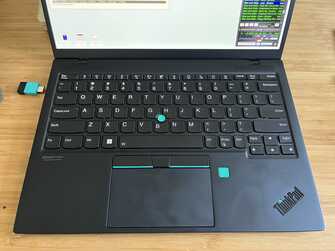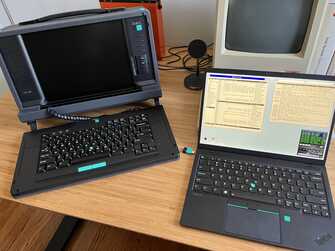OpenBSD on the Lenovo ThinkPad X1 Nano (1st Gen)
Lenovo has finally made a smaller version of its X1 Carbon, something I've been looking forward to for years.

Hardware
The X1 Nano is basically a 13" version of the 14" X1 Carbon, reducing its footprint, thickness, and weight. Availability in the US has been fairly limited (and expensive) at the moment, offering no WWAN or any customizable options, and Core i7 models are not shipping out for months. I purchased the Intel Core i5-1135G7 model with 16 GB of RAM and a 1 TB NVMe SSD. The only screen option currently available is a matte non-touch 2K display.
The X1 Nano (X1N1?) weighs 2.0 lbs compared to my previous X1C7's 2.4 lbs. The width is reduced from the 14" X1 Carbon's 12.71" to 11.53", depth from 8.54" to 8.18", and thickness from 14.95mm to 13.87mm.
On the left side of the laptop are two Thunderbolt 3-enabled (USB 4) USB-C ports and a headphone jack. The PCI ethernet device and its required dongle are no longer available, which is not really needed these days with non-Thunderbolt USB-C ethernet adapters being able to max out a gigabit ethernet connection (at least on non-OpenBSD platforms).
On the right side are just the fan vent and power button, which is now moved from about the middle of the side to the far-right edge. I find the power button very hard to press now, especially to hold it in for how ever many seconds it takes to force a hard power-off.
The Dolby Atmos sound system remains with its unfortunate branding still present on the left side of the keyboard deck. There are two up-firing speakers at the top of the keyboard deck, which sound excellent and loud.
The 13" 2K (2160x1350) matte, non-touch IPS screen looks great and is the same horizontal resolution as my 13" MateBook X which I've still been using for years. The resolution is high enough to use 1.5x scaling but low enough to not draw a lot of power. It can get very bright at 450 nits, and most of the time indoors I'm using it at about 40% brightness. I did a color calibration and it wasn't too far off the factory default.
The Nano has a ThinkShutter device to physically cover up the webcam lens as my X1 Carbon did, and retains the black "ThinkPad" branding on the keyboard deck.
The screen hinge is tight and cannot really be opened one-handed due to the reduced weight of the laptop. However, the lid does not wobble at all when typing.
The keyboard still seems full-sized, though the function-row keys are shorter.
The X1 Nano further reduces the X1C7's key travel from 1.5mm to 1.35mm, though
I still find it very enjoyable to type on and it retains a chunky tactile feel.
The keys do have a bit of a creaky sound when typing or just moving fingers on
keys without pressing them, though adding keyboard grease/lube under the most
egregious offenders quieted them down significantly.
The keyboard is backlit and offers two levels of adjustment with Fn+Space or
through wsconsctl keyboard.backlight on OpenBSD, or through software
utilities like
xdimmer.
The Elan touchpad surface remains soft and easy to glide fingers across, and its integrated "diving-board-style" button has a quiet thud for a click with no play in its mechanism. The three physical TrackPoint buttons between the keyboard and touchpad have a shallow click. The TrackPoint still operates over a legacy PS/2 attachment and the touchpad is a Windows Precision Touchpad connected over I2C as on the X1C7.
I am again using a far-superior "soft rim"-style TrackPoint cap as I did on my X1 Carbon, though the cap for the X1 Nano is even shorter at 3mm.
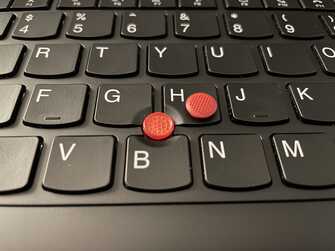
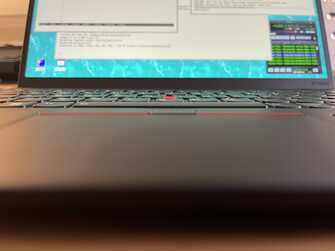
A square USB-attached fingerprint sensor sits unused next to the touchpad which I'd honestly forgotten was even there until I just looked at a picture.
Wireless connectivity is provided by a non-socketed Intel AX201 802.11ax WiFi and Bluetooth 5.1 chip. The original SSD was a Western Digital PC SN530 removable m.2 2242 form-factor SSD mounted under a heatsink, which I've since upgraded to a SanDisk WD PC SN740 2 TB SSD.
There is no audible coil whine. The fan has a tendency to come on rather eagerly when the CPU is allowed to use its full frequency with turbo, and to remain on for what seems like a long time even after the CPU-intensive operation has stopped and the surface of the laptop is cool to the touch. Fortunately the fan is rather quiet (~33 dBA about an inch from the exhaust outlet at the fan's highest setting) and has a neutral white-noise sound without any high-pitched whining. Perhaps a future update to the firmware/EC will adjust the temperature thresholds for the fan to come on less eagerly, and not stay on so long.
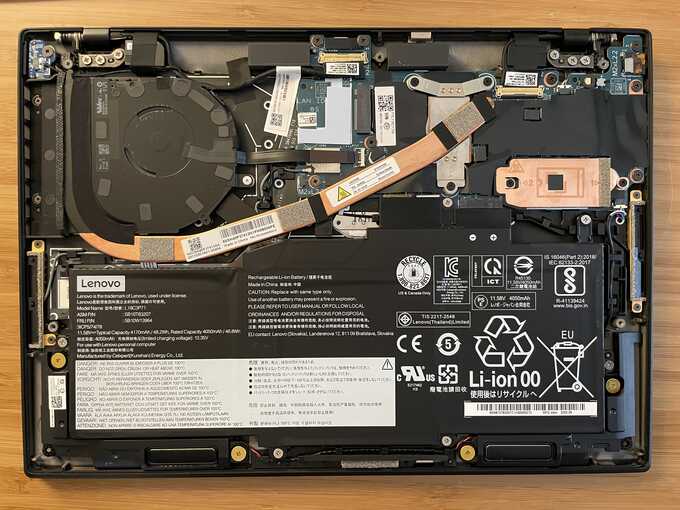
Firmware
The X1 Nano defaults to a graphical firmware upon pressing F1, which can be
switched back into a simple text mode.
F12 can be used to temporarily select a different boot device.
Pro-tip: press Fn+F1 to mute the speakers before pressing either of these
options to prevent a loud, annoying beep.
I recommend enabling the "F1-F12 as Primary Function" option to not require using the Fn key to register these keys.
Installing a different boot logo is still possible through Windows, which also gets rid of the new "TCO Certified" logo in the bottom-right corner.
Secure Boot must be disabled in the BIOS menu to boot OpenBSD, and a "CSM Support" option is no longer available (nor needed).
As of firmware version 1.43 the X1 Nano has a normal S3 suspend mode with the sleep option in the firmware menu set to "Linux".
Current OpenBSD Support Summary
Status is relative to OpenBSD-current as of 2023-06-13.
| Component | Works? | Notes |
|---|---|---|
| Audio | Yes | Intel audio with Realtek ALC287 codec and supported by azalia. Microphone can be disabled in the BIOS. |
| Battery status | Yes | 48Whr battery, status available through acpibat. |
| Bluetooth | No | Attaches as a ugen device, but OpenBSD does not support Bluetooth. Can be disabled in the BIOS. |
| Fingerprint sensor | No | Synaptics 00bd via USB, might be supported by libfprint with some extra firmware. Can be disabled in the BIOS. |
| Keyboard backlight | Yes | Supported natively by the EC. Can be toggled with Fn+Space and with wsconsctl keyboard.backlight values of 0, 50, and 100. |
| Hibernation | Yes | Can be triggered by ZZZ. |
| SSD | Yes | The nvme. |
| Suspend / resume | Yes | ACPI S3 suspend support requires a BIOS update and the S3 Sleep option set to "Linux". |
| Thunderbolt 3 | Yes | Thunderbolt ppb bridges magically appear when devices are plugged in; tested with nvme and bge. |
| Touchpad | Yes | Elan I2C, supported by imt. |
| TrackPoint | Yes | Supported by pms. |
| USB | Yes | The 2 USB-C ports work fine. |
| Video | Yes | inteldrm supports accelerated video, DPMS, gamma control, and integrated backlight control. HDMI output through a USB-C adapter works. |
| Webcam | Yes | Chicony USB, supported by the uvideo driver when the kern.video.record sysctl is enabled. Can be disabled in the BIOS. |
| Wireless | Yes | The non-removable Intel AX201 802.11ax wireless chip is supported by iwx. |
Updates
2021-01-17: The usual round of PCI device ID additions have been made, and
iwx has been
updated
to attach to the AX201 device found in the X1 Nano.
There are some minor issues with DPMS that cause the screen to take a few seconds longer to wake up after being shut off. Sometimes when returning to my laptop after it's been locked (and the screen turned off via DPMS) it blinks a few times before showing the screen contents.
2021-01-25: I've been experimenting with
adjustable fan control in acpithinkpad
to silence the fan at all times.
It doesn't seem to raise the temperature too high, and the laptop seems capable
of passively cooling itself down fairly well once CPU-intensive tasks have
stopped.
2021-01-27: I've also been working on
adding support for Intel HWP
as a modern replacement for OpenBSD's hw.setperf, where the
processors/firmware dynamically adjust their frequency on their own in response
to work load, rather than the OpenBSD kernel doing it.
2021-06-27: The X1 Nano now has a firmware update that adds a "Sleep State for Linux" option which emulates S3, however resuming does not yet work properly with OpenBSD.
2021-09-13: The S3 suspend and resume issue has been
fixed
with proper TPM 2.0 support in the tpm driver, so the X1 Nano can fully
suspend and resume in OpenBSD now as long as the BIOS is updated and the TPM is
enabled in the BIOS.
2023-06-13: I upgraded the original 512 GB Western Digital PC SN530 SSD to a 2 TB SanDisk WD PC SN740 SSD. While it's difficult to find a fast, high-capacity, single-sided SSD in 2242 form factor, the PC SN740 is a single-sided 2230 drive that is readily available in large capacities and can be adapted to 2242 size to fit the X1 Nano.
I also discovered by accident that Thunderbolt magically works without any
driver support on OpenBSD.
I plugged in a
Thunderbolt NVMe enclosure
to check whether it would fall back to USB attachment, but ppb, pci, and
nvme devices attached.
I verified with an Apple Thunderbolt 2 ethernet device (through a Thunderbolt 2
to 3 adapter) and it also attached as bge as expected, and detached properly
when unplugging.
2024-06-22: I created an internal USB port board to replace the fingerprint reader with a USB port to carry around my Logitech mouse dongle.
2024-06-24: I 3d-printed TPU replacements for the TrackPoint nub and fingerprint reader slots, and painted the TrackPoint buttons as an homage to Dolch systems:
